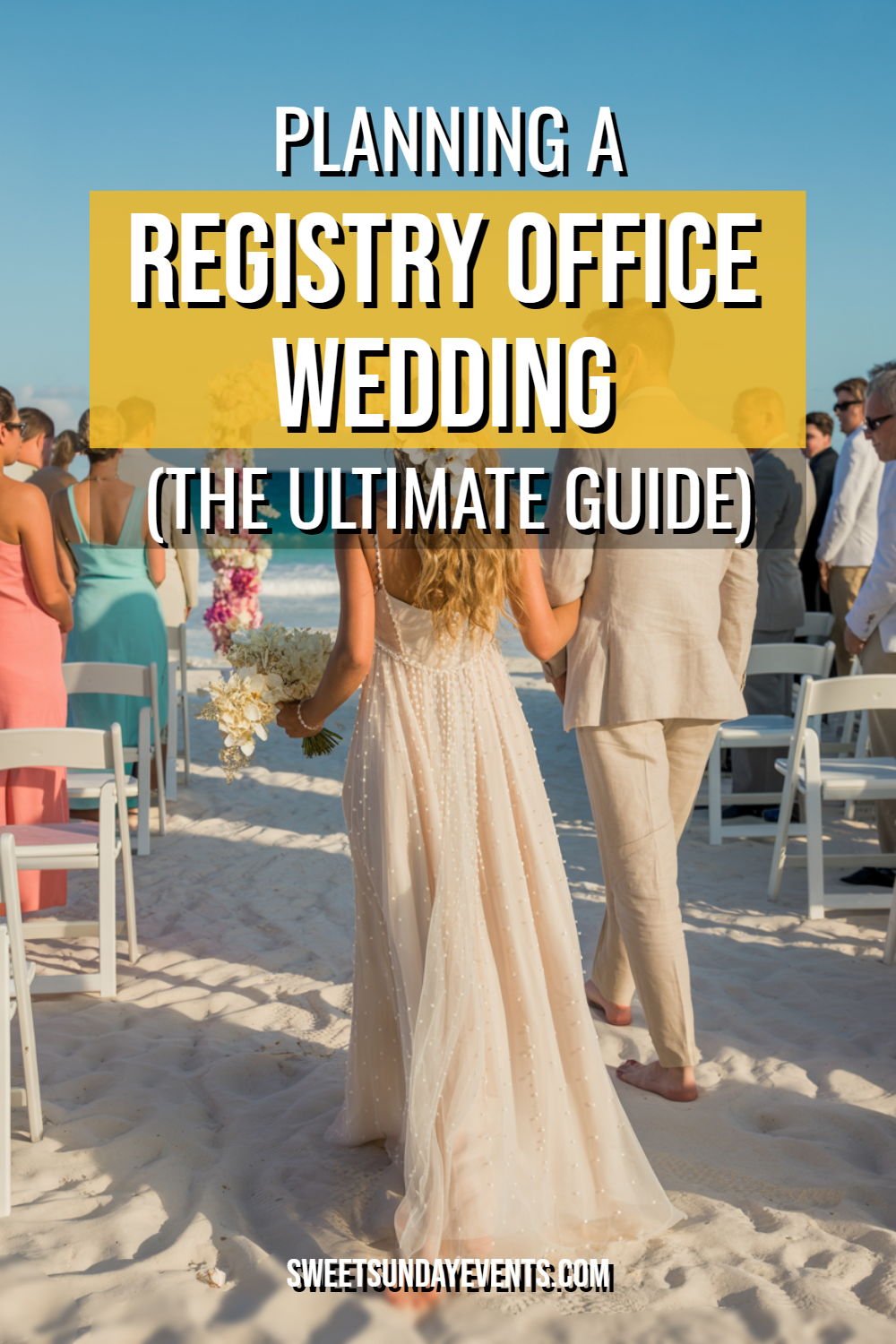Registry office weddings have shed their reputation as rushed, no-frills affairs. Today’s couples are choosing this intimate setting for reasons that go far beyond budget constraints—though let’s be honest, that financial freedom doesn’t hurt either.
Whether you’re planning a simple ceremony or want to add personal touches that rival any grand venue, here’s everything you need to know about making your registry office wedding absolutely perfect.
Legal Requirements and Documentation
Getting your paperwork sorted is non-negotiable, and it’s surprisingly more involved than many couples expect.
You’ll need to give notice at your local registry office at least 29 days before your ceremony, bringing birth certificates, proof of address, and divorce decrees if applicable.
Both partners must attend the notice appointment together. Don’t try to save time by having one person handle everything—it simply won’t work.
Foreign nationals face additional requirements, including visa documentation and potentially translated certificates. Check with your specific registry office well in advance, as processing times can vary significantly.
Booking Your Date and Time
Popular registry offices book up months in advance, especially for Saturday slots. Friday afternoons and weekday ceremonies offer more availability and often come with reduced fees.
Most offices offer multiple time slots throughout the day, typically lasting 20-30 minutes each. Morning ceremonies can feel fresh and optimistic, while afternoon slots allow for a celebratory lunch afterward.
Consider seasonal demand when booking. Spring and summer dates disappear quickly, but winter ceremonies have their own charm and significantly better availability.
Choosing the Perfect Registry Office
Not all registry offices are created equal, and you’re not necessarily stuck with your local one. Many areas allow you to marry at any registry office within the district, giving you options worth exploring.
Visit potential venues in person before making your decision. Photos on websites rarely capture the atmosphere or reveal potential drawbacks like poor lighting or cramped waiting areas.
Evaluating the Ceremony Room
The ceremony room sets the entire tone for your wedding day. Look for spaces with natural light, attractive architectural features, and enough room for your guest list without feeling cavernous or cramped.
Some registry offices offer multiple room options at different price points. The premium rooms often feature better acoustics, more elegant furnishings, and additional space for photographs.
Pay attention to practical details like parking availability, accessibility for elderly guests, and nearby facilities for pre-ceremony preparations. These seemingly minor factors can significantly impact your day’s flow.
Location and Logistics
Choose a registry office that’s convenient for the majority of your guests. Central locations with good public transport links work best, especially if you’re planning post-ceremony celebrations.
Consider the surrounding area for photography opportunities. Some registry offices are located in historic buildings or picturesque town centers that provide beautiful backdrops for your wedding photos.
Think about your post-ceremony plans when selecting location. If you’re heading straight to a restaurant or reception venue, proximity matters more than you might initially realize.
Guest List and Invitations
Registry office ceremonies typically accommodate smaller guest lists, which can be both liberating and challenging. Most venues handle 20-40 guests comfortably, though capacity varies significantly between locations.
The intimate nature forces you to prioritize your closest relationships. This can eliminate the stress of feeling obligated to invite distant relatives or workplace acquaintances.
Managing Expectations
Some family members might initially feel disappointed about missing a traditional church wedding or large celebration. Address these concerns directly and early in your planning process.
Emphasize the personal, meaningful nature of your chosen ceremony. Many guests find registry office weddings more emotionally impactful precisely because of their intimate scale.
Consider hosting a separate celebration or party for extended family and friends who can’t attend the ceremony. This allows you to maintain your intimate wedding while still including everyone in your joy.
Invitation Etiquette
Registry office wedding invitations can be more casual than traditional wedding stationery, but they should still convey the importance of the occasion. Include all essential details: date, time, exact address, and parking information.
Be clear about post-ceremony plans in your invitation. Guests need to know whether you’re heading to a restaurant, hosting a reception, or simply celebrating with drinks and cake.
Send invitations 6-8 weeks in advance for registry office weddings. The shorter planning timeline doesn’t require the extended notice period of larger weddings.
Personalizing Your Ceremony
Registry offices might seem limiting for personalization, but creative couples find numerous ways to make their ceremony uniquely theirs. The key lies in working within the legal framework while adding meaningful touches.
Most registry offices allow you to include personal vows alongside the required legal declarations. This gives you the opportunity to express your feelings in your own words.
Music and Readings
Civil ceremonies permit secular music and readings that reflect your personality as a couple. Choose songs that hold special meaning rather than defaulting to traditional wedding music.
Live music isn’t usually possible in registry offices, but recorded music can still create atmosphere. Discuss sound system capabilities and any restrictions with your registrar in advance.
Personal readings from friends or family members add warmth to the ceremony. Poetry, literary excerpts, or even meaningful song lyrics work beautifully in this setting.
Photography and Videography
Professional photography transforms registry office weddings from simple legal proceedings into beautifully documented celebrations. Most registry offices welcome photographers, though flash photography during the ceremony might be restricted.
Discuss photography logistics with both your photographer and the registry office staff. Understanding the space limitations and optimal positioning ensures you get the shots you want without disrupting the ceremony.
Consider hiring a photographer for a few hours rather than a full day. Registry office weddings often require less extensive coverage, making this a cost-effective option.
Planning Your Reception
Registry office ceremonies naturally flow into more relaxed celebrations. Without the traditional church-to-venue transition, you have flexibility in planning your post-ceremony activities.
Restaurant bookings work particularly well for registry office wedding receptions. The intimate guest count suits private dining rooms, and you can often negotiate special menus or pricing.
Venue Options
Hotels with private dining facilities offer a seamless transition from ceremony to celebration. Many provide wedding packages specifically designed for registry office couples.
Consider unconventional venues that reflect your interests: art galleries, historic houses, or even favorite pubs can host memorable receptions. The smaller guest list makes unusual venues more feasible.
Home receptions create the most intimate atmosphere possible. If you have suitable space, hosting at home allows complete control over every detail while keeping costs minimal.
Timing and Flow
Plan your reception timing carefully to maintain momentum after the ceremony. A gap longer than an hour can make the day feel disjointed.
Cocktail-style receptions work beautifully after registry office ceremonies. The relaxed format encourages mingling and creates a celebratory atmosphere without formal structure.
Consider the time of day when planning your reception style. Morning ceremonies naturally lead to lunch celebrations, while afternoon ceremonies suit evening parties.
Budget Considerations
Registry office weddings offer significant cost savings compared to traditional venues, but expenses can still add up quickly if you’re not careful. The ceremony fee typically ranges from £50-£500 depending on your location and chosen room.
Photography often represents the largest expense after the ceremony fee itself. Professional wedding photographers charge £500-£2000 for registry office coverage, depending on duration and package inclusions.
Cost Breakdown
| Expense Category | Typical Range | Notes |
|---|---|---|
| Ceremony Fee | £50-£500 | Varies by location and room |
| Photography | £500-£2000 | 2-4 hours coverage |
| Reception Venue | £200-£1500 | Depends on guest count |
| Flowers | £50-£300 | Bouquet and boutonniere |
| Outfits | £100-£1000 | Can be formal or casual |
| Transportation | £50-£200 | Often unnecessary |
Money-Saving Strategies
Weekday ceremonies cost significantly less than weekend slots at most registry offices. Tuesday through Thursday bookings often come with substantial discounts.
Seasonal timing affects costs beyond just the ceremony fee. Photographers, florists, and reception venues all charge premium rates during peak wedding season.
DIY elements work particularly well for registry office weddings. Simple flower arrangements, homemade favors, and personal decorations add charm without professional price tags.
What to Wear
Registry office weddings liberate you from traditional wedding attire expectations while still marking the significance of the occasion. Your outfit should reflect both the formality of marriage and your personal style.
Many brides choose elegant dresses rather than full wedding gowns. Midi-length or cocktail dresses work beautifully and can be worn again for other special occasions.
Dress Code Guidance
Grooms have similar flexibility with their attire choices. A well-fitted suit works perfectly, whether it’s a classic navy, charcoal gray, or even a more adventurous color choice.
Consider the season and time of day when selecting your outfit. Morning ceremonies suit lighter colors and fabrics, while evening celebrations call for more formal attire.
Comfort matters more than you might expect. You’ll be standing for the ceremony and likely celebrating afterward, so choose shoes and clothing that allow you to enjoy your day fully.
Final Preparations
The week before your registry office wedding should be relatively calm compared to traditional wedding preparations. Confirm final details with the registry office, photographer, and reception venue.
Prepare any personal vows or readings in advance. Practice reading them aloud to ensure you’re comfortable with the content and length.
Pack a small emergency kit with tissues, lip balm, and any touch-up makeup. Registry office facilities are often basic, so bringing essentials ensures you look your best.
Day-of Timeline
Arrive at the registry office 15-20 minutes before your scheduled ceremony time. This allows for any last-minute paperwork and helps you settle any pre-ceremony nerves.
Designate someone to coordinate with your photographer and manage any logistics. Having a point person allows you to focus on enjoying your moment.
Plan your exit strategy in advance. Whether you’re heading to a reception or simply leaving for photos, knowing your next steps prevents awkward lingering.
Making It Memorable
Registry office weddings succeed when couples embrace their unique advantages rather than trying to replicate traditional celebrations. The intimacy, simplicity, and focus on your relationship create memories that often feel more authentic than elaborate productions.
Your wedding day should reflect your values and priorities as a couple. If that means a simple ceremony followed by dinner with your closest friends, that’s absolutely perfect.


